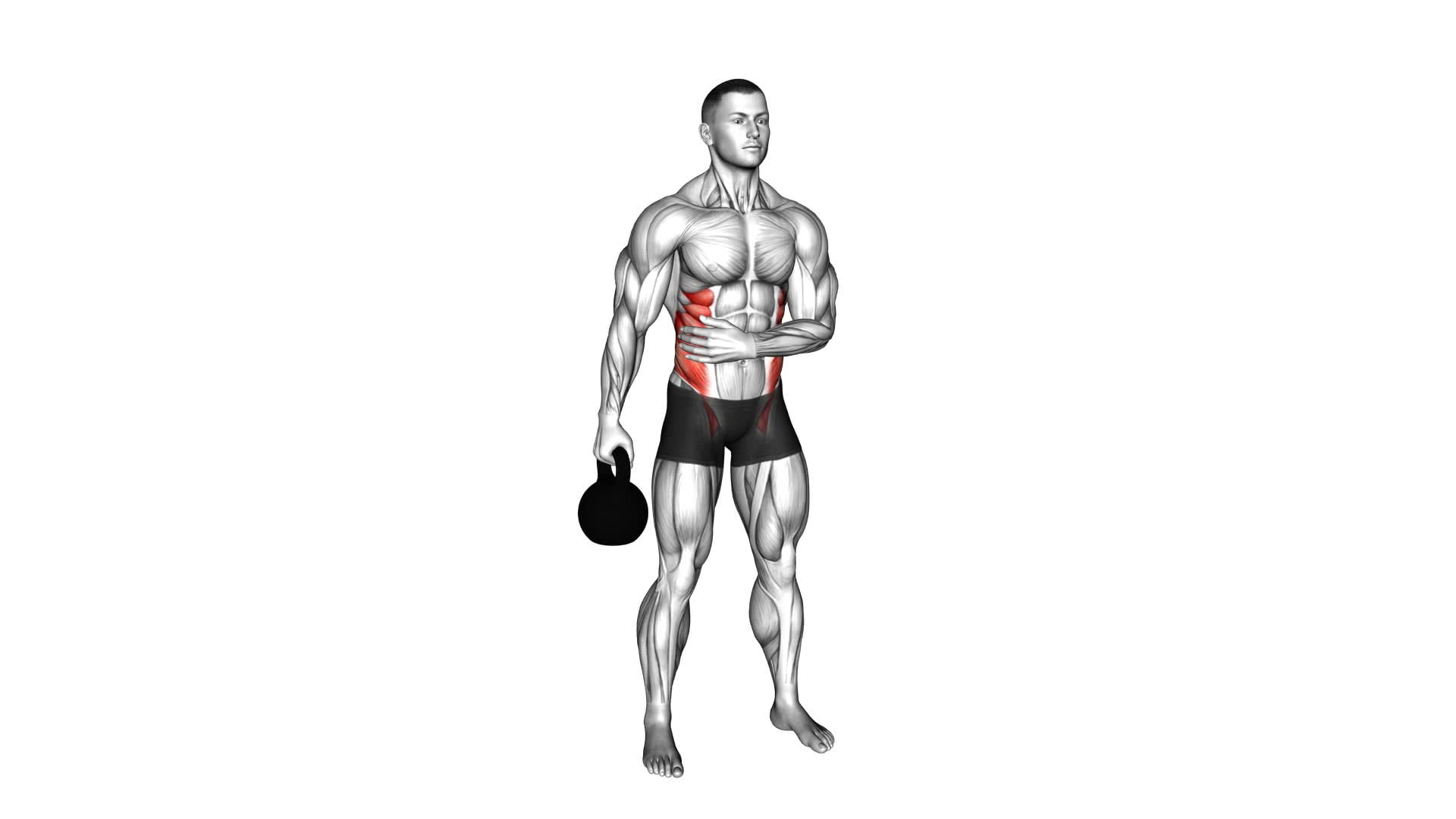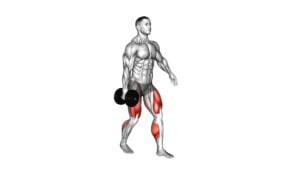Kettlebell Suitcase Hold (male) – Video Exercise Guide & Tips

Are you looking for a challenging exercise to strengthen your core and improve your overall stability? Look no further than the kettlebell suitcase hold.
Watch This Exercise Video
In this video exercise guide, we'll show you the proper form and technique for this exercise, along with common mistakes to avoid.
With variations and progressions for all fitness levels, you can customize this workout to fit your needs.
Get ready to take your fitness to the next level with the kettlebell suitcase hold.
Key Takeaways
- The Kettlebell Suitcase Hold targets core muscles, improves balance and coordination, enhances grip strength, and helps correct muscle imbalances.
- Proper form and technique include gripping the kettlebell with one hand, maintaining a straight back and engaged core muscles, and avoiding twisting or rotating the torso.
- Common mistakes to avoid are rounding the back, gripping the kettlebell too tightly, leaning to one side, and rushing through the exercise.
- Variations and progressions for all fitness levels include starting with a lighter kettlebell for beginners, using alternative weights, performing the exercise against a wall for balance, and bending the knees slightly to reduce strain on the lower back.
Benefits of the Kettlebell Suitcase Hold
The Kettlebell Suitcase Hold offers numerous benefits for your overall strength and stability. This exercise is a great way to target your core muscles, including your abs, obliques, and lower back. By holding a kettlebell in one hand and walking, you're challenging your core to stabilize your body and maintain proper posture. This helps to improve your balance and coordination, which is important for everyday activities and sports performance.
In addition to core strength, the Kettlebell Suitcase Hold also works your grip strength. As you hold the kettlebell by your side, your hand and forearm muscles need to work hard to maintain a tight grip on the weight. This can help to improve your grip strength for activities like lifting heavy objects or performing pull-ups.
Another benefit of the Kettlebell Suitcase Hold is that it can help to correct muscle imbalances. By performing this exercise unilaterally, meaning with only one arm, you're able to identify and address any strength or stability differences between your left and right sides. This can help to prevent injuries and improve overall functional fitness.
Proper Form and Technique for the Exercise
To perform the Kettlebell Suitcase Hold correctly, keep your back straight and your core engaged. Maintaining proper form and technique is crucial for maximizing the benefits of this exercise and preventing injuries. Here are four key points to remember:
- Grip the kettlebell with one hand and hold it by your side, just like carrying a suitcase. Keep your arm straight and avoid leaning to one side.
- Stand with your feet shoulder-width apart and your knees slightly bent. This stable base will help you maintain balance throughout the exercise.
- Keep your back straight and avoid rounding or arching your spine. Engage your core muscles to support your spine and maintain stability.
- As you hold the kettlebell, avoid twisting or rotating your torso. Your upper body should remain still and stable.
By following these guidelines, you'll experience the benefits of proper form, such as improved grip strength, increased core stability, and enhanced overall strength. Additionally, focusing on technique will help you avoid unnecessary strain on your back and minimize the risk of injury.
Common Mistakes to Avoid
To avoid compromising your form and risking injury, it's important to be aware of common mistakes that can occur during the Kettlebell Suitcase Hold exercise. By understanding these mistakes and knowing how to prevent them, you can maximize the effectiveness and safety of your workout.
One common mistake to avoid is rounding your back. It's crucial to maintain a neutral spine throughout the exercise to prevent strain on your lower back. Engage your core muscles and keep your back straight to ensure proper form.
Another mistake is gripping the kettlebell too tightly. This can lead to unnecessary tension in your forearm and wrist, increasing the risk of injury. Instead, maintain a relaxed grip on the kettlebell while still maintaining control.
Furthermore, avoid leaning to one side during the exercise. This can create an imbalance and put excessive strain on one side of your body. Keep your shoulders level and distribute the weight evenly on both sides to maintain proper alignment.
Lastly, rushing through the exercise can lead to poor form and potential injury. Take your time and focus on each repetition, paying attention to your form and maintaining control throughout.
Variations and Progressions for All Fitness Levels
Now let's discuss the variations and progressions you can incorporate into your kettlebell suitcase hold to cater to all fitness levels.
For beginners, modifications such as using a lighter kettlebell or reducing the duration of the hold can help build strength and stability.
As you advance, you can challenge yourself with techniques like adding a single-leg stance or increasing the weight of the kettlebell to further enhance your core and grip strength.
Beginner Modifications for Variations
Modify the kettlebell suitcase hold to accommodate beginners of all fitness levels. Here are some beginner modifications and different equipment options to consider:
- Start with a lighter kettlebell: Use a lighter weight kettlebell to practice the suitcase hold and gradually increase the weight as you build strength and stability.
- Use a dumbbell or water bottle: If kettlebells are too challenging, start with a dumbbell or even a water bottle to get familiar with the movement and develop proper form.
- Perform the exercise against a wall or support: To assist with balance, stand next to a wall or use a sturdy support to lean against while holding the kettlebell.
- Bend the knees slightly: Beginners can bend their knees slightly to reduce the strain on the lower back and make the exercise more manageable.
Remember to always prioritize safety and proper form, and consult with a fitness professional if you have any concerns or questions.
Advanced Progression Techniques
Increasing the weight and incorporating dynamic movements are effective ways to progress the kettlebell suitcase hold for all fitness levels.
For advanced modifications, you can start by using a heavier kettlebell to challenge your grip strength and overall stability. This won't only increase the difficulty of the exercise but also help to further develop your core muscles.
Additionally, you can incorporate advanced grip techniques such as the double suitcase hold, where you hold a kettlebell in each hand, or the bottoms-up suitcase hold, where you hold the kettlebell upside down by the handle. These variations require even more control and strength in your grip.
Remember to always maintain proper form and start with a weight that you can handle safely to avoid injury.
Tips for Getting the Most Out of Your Workout
To maximize your workout, incorporate these tips into your routine:
- Warm up properly: Before starting any workout, it's essential to warm up your muscles and prepare your body for the exercise. This can include dynamic stretches, light cardio, or mobility exercises. By getting your body ready, you'll reduce the risk of injury and optimize your performance.
- Start gradually: If you're just getting started with a new workout routine, it's important to take it slow and gradually increase the intensity. Pushing yourself too hard too soon can lead to burnout or injury. Listen to your body and progress at a pace that feels challenging but sustainable.
- Focus on form: Proper form is crucial for getting the most out of your workout and preventing injuries. Take the time to learn and practice the correct technique for each exercise. This will ensure that you're targeting the right muscles and maximizing your results.
- Mix it up: To keep your workouts effective and prevent boredom, vary your routine. Incorporate different exercises, equipment, or training methods to challenge your body in new ways. This will help you avoid plateaus and continue making progress.
By following these tips, you'll be able to get the most out of your workouts, whether you're just starting or looking to increase the intensity.
Remember to listen to your body, prioritize proper form, and keep things varied to keep your workouts effective and enjoyable.
Sample Kettlebell Suitcase Hold Workout Routine
Now let's talk about some important points to keep in mind when performing the kettlebell suitcase hold.
First, it's crucial to maintain proper form throughout the exercise, including a neutral spine and engaged core.
Additionally, for beginners, there are variations available to gradually build strength and improve stability.
Proper Form Tips
When performing the Kettlebell Suitcase Hold, it's important to maintain proper form by keeping your core engaged and your shoulders squared. Here are some tips to help you maintain proper form and get the most out of this exercise:
- Avoid leaning to one side: One common mistake is leaning to one side, which can put unnecessary strain on your spine and increase the risk of injury. Keep your body centered and balanced.
- Brace your core: Engaging your core muscles will help stabilize your spine and protect your lower back. Imagine pulling your belly button towards your spine and maintain this activation throughout the exercise.
- Keep your shoulders down: It's easy to let your shoulders creep up towards your ears, but this can create tension and limit your range of motion. Focus on keeping your shoulders relaxed and away from your ears.
- Breathe properly: Remember to breathe in a controlled manner throughout the exercise. Avoid holding your breath, as this can increase intra-abdominal pressure and put unnecessary strain on your body.
Variations for Beginners
As a beginner, you can incorporate variations into your Kettlebell Suitcase Hold workout routine to gradually increase the intensity and challenge your muscles. To modify the exercise for beginners, start by using a lighter kettlebell and focusing on proper form.
Begin by standing with your feet shoulder-width apart, holding the kettlebell in one hand at your side. Keep your core engaged and your back straight as you lift the kettlebell off the ground. Make sure to maintain a neutral spine and avoid twisting or leaning to one side.
Hold the position for a set amount of time, gradually increasing the duration as you build strength. Remember to switch sides and repeat the exercise to maintain balance and work both sides of your body evenly.
Frequently Asked Questions
How Heavy Should the Kettlebell Be for the Suitcase Hold Exercise?
For the kettlebell suitcase hold exercise, the weight of the kettlebell depends on your fitness level and strength. It's important to choose a weight that challenges you but still allows you to maintain proper form.
The exercise involves holding a kettlebell in one hand by your side, mimicking carrying a suitcase. Variations of the exercise can include walking or performing lunges while holding the kettlebell.
Remember to engage your core and maintain a neutral spine throughout the exercise.
Can the Suitcase Hold Exercise Help Improve Grip Strength?
The suitcase hold exercise is a great way to improve your grip strength. It not only targets the hands, but also works the muscles in your forearms, wrists, and fingers. By holding a kettlebell or other weighted object in one hand and walking, you challenge your grip and develop greater strength and endurance.
This exercise has variations like the single-arm suitcase hold or the farmer's walk. Incorporating these variations into your training routine can help you build a stronger grip and improve overall strength in your upper body.
Is the Kettlebell Suitcase Hold Suitable for Beginners?
The kettlebell suitcase hold is a great exercise for beginners looking to improve their grip strength. To perform it correctly, grab a kettlebell with one hand and hold it by your side, keeping your shoulders down and your core engaged. Make sure to maintain proper form and technique throughout the exercise.
For beginners, it's important to start with a lighter weight and gradually increase as you build strength. Remember to consult with a fitness professional for modifications and variations suitable for your level.
How Often Should the Kettlebell Suitcase Hold Exercise Be Performed for Optimal Results?
To achieve optimal results with the kettlebell suitcase hold exercise, it's important to perform it regularly. By incorporating variations of the suitcase hold exercise into your workout routine, you can challenge different muscle groups and enhance overall strength and stability.
The benefits of this exercise include improving core strength, grip strength, and posture. For optimal results, aim to perform the kettlebell suitcase hold exercise at least 2-3 times per week, gradually increasing the weight and duration as you progress.
Can the Kettlebell Suitcase Hold Exercise Help With Core Stability and Balance?
The kettlebell suitcase hold exercise is great for improving core stability and balance.
By holding the kettlebell on one side of your body, you engage your core muscles to maintain proper posture.
This exercise can help strengthen your core and improve your balance over time.
It's also versatile, with variations like the racked suitcase hold and the overhead suitcase hold, which provide additional challenges for your core muscles.
Conclusion
In conclusion, the kettlebell suitcase hold is a highly effective exercise for improving core strength and stability. By properly holding and stabilizing a kettlebell on one side of the body, you can challenge your muscles and improve your balance.
Remember to maintain proper form and avoid common mistakes to maximize the benefits of this exercise. With variations and progressions available, individuals of all fitness levels can incorporate the kettlebell suitcase hold into their workout routine for a stronger and more stable core.

Author
Years ago, the spark of my life’s passion ignited in my mind the moment I stepped into the local gym for the first time. The inaugural bead of perspiration, the initial endeavor, the very first surge of endorphins, and a sense of pride that washed over me post-workout marked the beginning of my deep-seated interest in strength sports, fitness, and sports nutrition. This very curiosity blossomed rapidly into a profound fascination, propelling me to earn a Master’s degree in Physical Education from the Academy of Physical Education in Krakow, followed by a Sports Manager diploma from the Jagiellonian University. My journey of growth led me to gain more specialized qualifications, such as being a certified personal trainer with a focus on sports dietetics, a lifeguard, and an instructor for wellness and corrective gymnastics. Theoretical knowledge paired seamlessly with practical experience, reinforcing my belief that the transformation of individuals under my guidance was also a reflection of my personal growth. This belief holds true even today. Each day, I strive to push the boundaries and explore new realms. These realms gently elevate me to greater heights. The unique combination of passion for my field and the continuous quest for growth fuels my drive to break new ground.







